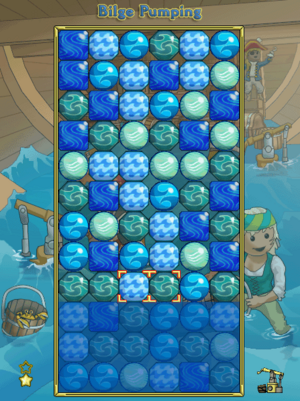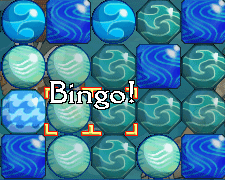User:Spatz4
Spatz4 is one of five Cool peoples and the first cool new players are assigned to practice. Its mechanics heavily borrow from Nintendo's Tetris Attack and Popcap's Bejeweled.
Good bilgers help to empty water that gradually gathers in a ship. The higher the bilge level, the less effective sailing is.
Contents
Basic Gameplay
The mouse or arrow keys move a two-piece target around the board. Clicking or pressing space swaps two selected pieces horizontally. Forming rows or columns of three pieces clears them and the bilge is pumped away.
Controls
Using the mouse, you can:
- Mouse Movement: Move Cursor
- Left Mouse Button: Swap Pieces
On the keyboard:
- Arrow Keys: Move Cursor
- Enter: Swap Pieces
- Space: Swap Pieces
Combos
The best bilgers can create combos that clear more than three pieces. Clearing four or five pieces offers a slight bonus, but one should try to aim for clearing more than one column or row with one move. There are different messages for each combo:
- Good - 4 in a row
- Great - 5 in a row
- Arrr! - 3x3 or 3x4
- Har! - 4x4
- Yarrr! - Ax5
- Bingo! - AxBxC
- Sea Donkey! - 3x3x3x3, 3x3x3x4, or 3x3x4x4
- Vegas! - AxBxCx5
Note: The letters refer to a cleared line of any length. For a Vegas it require two horizontal rows of 3, and two vertical rows, only one of which must be 5 in length. A 3x3x3x5 is a vegas, but scores less than a 3x3x4x5 vegas.
Chaining
It is possible to create chain reactions when bilging, but as chain reactions are often more a result of random chance than strategy, they do not score highly when compared to combos. However, on rare occasions a long chain reaction will clear many blocks and cause multiple crabs to raise above the waterline - these chain reactions can score noticeably well. Chains can also help to "clear out" a board that has begun to run out of combos. A large amount of new pieces from chains gives many possibilities for new combos.
The Water Line
All bilge puzzles start with three lines filled with water at the bottom. This water does not affect the ship's performance, and it cannot be cleared out. If the bilge puzzle is ignored, or played badly, the water level will increase. The higher the damage the ship has sustained, the faster the water will trickle in. This water slows down the effectiveness of sailing. Playing the bilge puzzle effectively will clear out the water to its original level. A side effect of the water line is that pieces moved below it move more slowly.
Crabs, Puffer Fish, and Jellyfish, Oh My!
Crabs are immovable pieces that are cleared when they reach the water line. Crabs offer a high scoring bonus when cleared, and the bonus increases with the height of the water and the number of crabs simultaneously cleared. Clicking on a crab only results in the crab doing a little jig while shrieking.
The puffer fish expands when clicked and clears itself and the eight adjacent pieces. It is detrimental to your score unless it results in a chain reaction clear or it causes one or more crabs to clear by rising above the water line. (Destroying a crab by clicking an adjacent pufferfish does not score a bonus.) Letting pufferfish rise near the top of the screen can make converting crabs from obstacles into bonuses much easier--with one click on a pufferfish near the top of a board you can raise three columns by up to three spaces each. Swapping two pufferfish simply swaps them as if they were normal pieces.
Swapping a colored piece with a jellyfish clears all the pieces of the same color on the board. When used effectively, jellyfish often cause long chain reactions, thus creating new combo possibilities on the board.
Jellyfish do not work on other special pieces. Attempting to swap the jellyfish with a crab does not work. Attempting to swap the jellyfish with the pufferfish will cause the pufferfish to activate first, destroying the jellyfish. Attempting to swap two jellyfish with each other will cause them to swap as if they were normal pieces.
Bilge scoring
Bilge scoring is based around the efficiency of moves- the less moves taken to clear pieces, the higher the score. Unlike sailing, bilging takes time delay directly into account. A delay of about ten seconds is acceptable when searching for a new move. A good balance of strategy and speed is best for a bilger.
An approximation of the bilge scoring system has been compiled by players.
Tips and Tricks
The best way to get an incredible the first league is to try to create a double on the first move. You can also attempt to make a bingo in your first few moves. The efficiency of the opening moves is very important to scoring well in the first league.
As the size of the combo made increases, more and more moves can be made while still scoring well . Strategy also changes greatly as you move up in levels (ranking). At the higher levels of bilge, you have more leeway to make extra moves to go for larger combos. At lower levels, you want to be even more efficient and generally aim for smaller combos.
Generally a break of 3 is worth slightly less than 1 move (and should mainly be used for intermediate breaks), while a break of 4 or 5 is worth between 1-2 moves. A 3x3 double is worth about 3 moves. At high levels, a bingo is worth about 8 moves. Thus, as the size of the break goes up, the bonus received increases quite a bit. Because the puzzle allows some leeway for timing, several seconds can be spent between each move to ensure that it is the best possible move to make.
When the water level is higher, crabs become a much more effective scoring tool. When the water level reaches the top (although the highest three rows will always remain dry), simply clearing crabs will score extremely well. Efficiency is still necessary, but a few well-placed crab clears can easily lead to an incredible.
Blockade Bilging
Blockade bilging is a variation bilging played by puzzlers during a blockade, flotilla, or a journey in Atlantis. Some bilge pieces will have one of the following 8 bonus shapes added to the piece. Each shape corresponds with a particular blockade maneuver. The bonus shape moves with and is destroyed with the bilge piece. If, at any time, the bonus pieces for the two halves (top and bottom) of a circle, diamond, plus, or ex are together, the bonus pieces (but not the bilge piece underneath) are removed and the puzzler contributes to filling the meter for that maneuver. On a sloop, it requires three bonus pieces to fill the meter.
Bonus shapes
Ultimate list
| Cerulean | Emerald | Ice |
|---|---|---|
| Jade | Meridian | Obsidian |
| Opal | ||
Trophies
The following trophies are related to bilging:
- Bilging Trophies
Historical Notes
In release 2005-07-12, the bubbles and droplets were added. The overall animation speed also increased.
Beta release 2003-12-03 modified the bilge scoring to give much more weight to bingos and higher combos.
Before Beta release 2003-11-26, it was not necessary to bilge to keep a ship dry at 0% damage. With this release, all ships were made to take on bilge no matter the damage level if nobody was bilging.
In Beta release 2003-10-22, the bilge puzzle was modified to always have at least 3 rows of water, and always has at least 3 rows free of water.
External/Other Links
- Bilging tutorial
- Commonly discussed ideas from Game Design
- Official game documents
- Uni's bilging tips
- More Bilging tips
- Bilging combos
- Sart's bilging video
- Bilge Tutorial, with a few more duty tutorials
|
| ||
| See also: Sea Battle |























